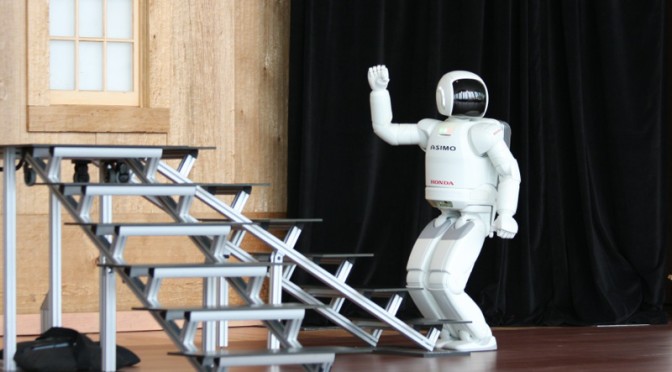It’s kind of like a mirror we hold up to ourselves. Whatever robots turn out to be, will largely be a function of us and the decisions we make.
– Mark Rowlands, D.Phil. Professor of Philosophy, University of Miami from Honda’s Living With RobotsPart of the fascination of robots is just that. It’s just another way of reflecting on the inner process of self-understanding, of trying to discern who we are.
– Wendell Wallach, Chair, Technology & Research Ethics Group, Yale from Honda’s Living with Robots
Played hooky with the squids on Friday to check out Honda’s Asimo robot at the Canadian Museum of Civilization. It danced, it climbed stairs, and it ran across the stage at a respectable 6 km/h. Asimo has been more than twenty years in the making but, according to Honda engineers and scientists, it still has a long way to go to become as fully-functioning as, say, Rosey the Robot of The Jetsons fame.
It’s interesting how Honda staff spend a significant portion of the video explaining how robots aren’t inherently “evil” or “creepy.” Apparently there is a very delicate line between the look we humans are willing to accept in our robots and what makes us feel uneasy and, they argue, Hollywood doesn’t help (or maybe we’re not meant to feel totally comfortable with our God-like artificial intelligence aspirations?)
Asimo and other robots and robotic devices, like cyborg suits, are part of a growing body of research around Ambient Assisted Living. The purpose of AAL is to remotely assist and monitor seniors and others requiring physical or mental assistance to live independently for as long as possible. It may mean popping Granny in a cyborg suit to help her move more easily and safely, strapping on a walking assist device, having a humanoid robot follow her from room to room and remind her to take her medication, or kitting her apartment out with remote sensors that gauge her mobility and ability to perform critical self-help tasks. Click here for Scientific American’s perspective on the possibilities and limitations of robot elder care. I am particularly interested in what Eric Dishman, Intel Director of Health Innovation and Policy has to say about their research around AAL.
[ted id=797]
I don’t think it’s a giant leap to Intel’s remote sensoring solutions from where we currently stand. We’re accustomed to computers, simple home robotics like the Roomba, and Skype, which permits a type of remote monitoring although we generally don’t think of it in those terms. But I don’t think that technology can ever entirely replace the relationship with live human beings. I am uneasy with the thought of Granny walking around holding the hand of a humanoid robot for company. It’s dehumanizing and seems a slippery slope to viewing our elders as ‘things’ that can be managed by other ‘things’. But I can see why this technology is attractive. It’s less emotionally messy to deal with elders via computer, or even telephone, than it is to interact with them face-to-face and feel their tremendous loneliness and frustration around an increasing loss of control. It’s a whole lot more difficult to walk out on your weeping mom or dad than it is to ‘click and close’ a remote conversation. The Technological Citizen blog reflects on the ethics of modern technology and provides a review of the provocative book Moral Machines by Wendell Wallach and Collin Allen.
I can understand the added benefits of these technological marvels but is not the issue with our modern, transient lifestyle choices and the fact that elder human beings are living alone in the first place? Does the answer not lie in more effective housing arrangements, more social connectedness, more rootedness in place, and more human contact not less?
